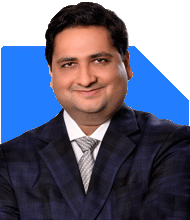Ramalingam Kalirajan |10894 Answers |Ask -Follow
Mutual Funds, Financial Planning Expert - Answered on Apr 12, 2024
He has an MBA in finance from the University of Madras and is a certified financial planner.
He is the director and chief financial planner at Holistic Investment, a Chennai-based firm that offers financial planning and wealth management advice.... more

Hello Sir, I am Sumit. I have been investing in MF since 2018 via regular SIP and lumpsum amounts as per the availability of funds. At present I am having following SIP in my account (1) DSP Flexicap Fund (Rs. 15000), (2) ICICI Prud Banking and Financial (Rs. 10000), (3) Kotak Emerging Equity Fund (Rs 15000), (4) Nippon Small Cap Fund (Rs 5000), (5) Kotak Focused Equity Fund (Rs 10000) and Also following in my mother's name (a) Axis MidcapFund (Rs 5000), (b) DSP Flexicap Fund (Rs 5000) Till May 2023 the SIP was of Rs 40000 which I have increased to 55000 from my account. I have invested around Rs 53 lakh till Dec 2023 and its value as per the present market rate is Rs 81 Lakh. Are these Funds / SIPs properly spread out ? I intend to create 2 Cr by June 2025. Please advise on existing funds or changes to be done. Thank you.
Diversification: Your portfolio seems heavily focused on equity funds, especially mid-cap and small-cap funds. While these funds can offer higher growth potential, they also come with higher risk. Consider diversifying into other categories like large-cap or flexi-cap funds to spread out risk.
Performance Review: Evaluate the performance of each fund in your portfolio relative to its benchmark index and peers. If any fund consistently underperforms or does not align with your investment objectives, consider replacing it with a better-performing alternative.
Risk Assessment: Given your goal of achieving Rs 2 Crore by June 2025, assess whether your current asset allocation aligns with your risk tolerance and investment horizon. Adjust your portfolio composition accordingly to balance risk and return potential.
Continued Monitoring: Keep a close watch on market developments, economic indicators, and fund performance. Regularly review your portfolio to ensure it remains aligned with your financial goals and make adjustments as necessary.
Consultation: Consider consulting with a financial advisor who can provide personalized guidance based on your financial situation, goals, and risk profile. They can help you optimize your portfolio and make informed investment decisions.
Remember that achieving your financial goals requires patience, discipline, and periodic review of your investment strategy. By staying informed and making prudent investment decisions, you can work towards building wealth and achieving your objectives.
You may like to see similar questions and answers below
Omkeshwar Singh | Answer |Ask -Follow
Head, Rank MF - Answered on Oct 13, 2022
Omkeshwar Singh | Answer |Ask -Follow
Head, Rank MF - Answered on Oct 13, 2022
Hardik Parikh | Answer |Ask -Follow
Tax, Mutual Fund Expert - Answered on Apr 19, 2023
Ramalingam Kalirajan |10894 Answers |Ask -Follow
Mutual Funds, Financial Planning Expert - Answered on Jun 25, 2024
Radheshyam Zanwar |6747 Answers |Ask -Follow
MHT-CET, IIT-JEE, NEET-UG Expert - Answered on Dec 16, 2025
Shalini Singh |181 Answers |Ask -Follow
Dating Coach - Answered on Dec 16, 2025
Patrick Dsouza |1429 Answers |Ask -Follow
CAT, XAT, CMAT, CET Expert - Answered on Dec 16, 2025
Nayagam P P |10858 Answers |Ask -Follow
Career Counsellor - Answered on Dec 16, 2025
Nayagam P P |10858 Answers |Ask -Follow
Career Counsellor - Answered on Dec 16, 2025
Samraat Jadhav |2510 Answers |Ask -Follow
Stock Market Expert - Answered on Dec 16, 2025
Samraat Jadhav |2510 Answers |Ask -Follow
Stock Market Expert - Answered on Dec 16, 2025
Nayagam P P |10858 Answers |Ask -Follow
Career Counsellor - Answered on Dec 16, 2025
Nayagam P P |10858 Answers |Ask -Follow
Career Counsellor - Answered on Dec 16, 2025
Ramalingam Kalirajan |10894 Answers |Ask -Follow
Mutual Funds, Financial Planning Expert - Answered on Dec 16, 2025



























